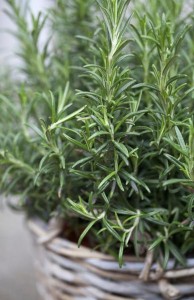Early spring the time to start an herb garden from seed
Chronicle Media — April 8, 2016
Rosemary is a reliable plant for a container garden. (Photo courtesy of University of Illinois Extension)
Herbs are popular in many gardens, but it can be expensive to buy and transplant mature plants. That’s why University of Illinois Extension horticulture educator Nancy Kreith recommends starting herbs from seed indoors.
Early spring is a good time to begin.
Thyme, rosemary, basil, sage, chives, and tarragon are good candidates for starting indoors. Many of these plants have very fine seeds and require a long germination period. If started early in March, they can be ready to transplant into the garden in mid to late May, depending on the region. Refer to Illinois State Water Survey for average frost free dates in your region at: www.isws.illinois.edu.
To start herb seeds indoors, use a peat-based soil-less seed-starting mix in a 3- to 4-inch-deep container or seed-starting flat with drainage holes. Pre-moisten the mix with water until it feels like a wrung-out sponge. Fill labeled containers with the moist mix, leaving about one-quarter inch of space at the top.
“Labeling containers with the herb name and planting date will avoid confusion when it comes time to plant outside,” Kreith says.
Plant at least five seeds (or a pinch) of one herb variety per container or cell and lightly cover with moist mix.
“As a general rule of thumb, plant seed just two times its thickness under the soil,” Kreith notes. “As plants become overgrown, seedlings can be thinned to one plant per pot.”
After planting the seeds, keep them moist during the germination period.
“One technique is to cover the flat or container with a clear plastic bag,” Kreith says. “The plastic helps hold in heat and aids in providing consistent moisture. However, be sure to monitor the growing media for mold growth. If you see mold, poke holes in the bag or remove it completely to improve air circulation.”
Plastic should be removed once the seeds germinate, usually in 10 to 14 days. A heat mat, available at many gardening stores, will speed the germination rate if placed under the container.
The sown containers or flats need approximately six hours of sunlight per day. A window with either western or southern exposure will work well initially, but over time, the herb seedlings will require more direct and intense lighting. Using supplemental grow lights or fluorescent lighting has been proven to work better than natural sunlight.
“If using fluorescent lights, keep them on for a minimum of 10 hours per day and place them as close to the seedlings as possible,” Kreith says. “Adjust the height as seedlings grow taller.”
Seeds and seedlings should be monitored on a daily basis as the transplants mature; look for insects, rot, and extremely dry soil. The seeds and seedlings should only need a light sprinkle of water about twice per week, depending on the temperature of the home. Allow the planting media to dry out a little before watering again. Overwatering can lead to diseases such as damping-off, a common soilborne fungal disease that ultimately kills young seedlings. Constant moisture can also attract fruit flies.
As seedlings mature, some maintenance will be needed. If seedlings grow too large for their original containers, they can be transplanted into larger ones. If they become leggy, they may not be getting enough light.
“Be sure fluorescent lights are placed close enough to the plants, no more than four inches away,” Kreith says. “You can also increase the amount of time lights are on, up to 16 hours per day.”
Once seedlings reach six to eight weeks old, pinch off the top leaves to encourage lateral spread and a bushier appearance. After 10 weeks, most herb seedlings should be ready to transplant outdoors.
“Help the tender plants ‘harden off,’ or become acclimated to their new climate, by placing them outdoors on mild sunny days and bring them back indoors at night for one to two weeks,” Kreith recommends. “Once plants are hardened off, they can be transplanted safely into the garden for beautification, culinary, and therapeutic purposes.”
Some seeds can be sown directly in the ground around the time that transplants are ready to be planted outdoors. Herbs that do well by direct sowing include cilantro, arugula, and basil. In early spring, direct-seeding cilantro and arugula, both cool-weather herbs, provide a bountiful leafy harvest from mid-spring to mid-summer. Warm season herbs like basil can also be directly sown after the danger of frost has passed.
For the best flavor, harvest herbs just before they flower. Details about specific herbs, their growing requirements, and harvesting and storing methods can be found at extension.illinois.edu/herbs/. Nancy Kreith, kreith@illinois.edu.
Related content
Try growing these unusual vegetables in the garden
Square-foot gardening utilizes small areas
— Early spring the time to start an herb garden from seed —



